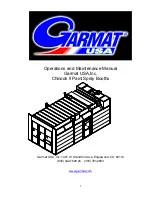
Operating and Maintenance Manual
9 |
P a g e
D e c a p p e r O & M M a n u a l R e v D
8.
As the motor continues to rotate, the decapper lifts, and the new
case is pushed into position. As the case moves into position it will
push the previous case out.
9.
As the case is pushed out the pegs will “snap”
and the case will be
thrown into the drop chute. IF THE CASE PUSHER IS NOT
CORRECTLY ADJUSTED THEN CASES WILL OFTEN FALL OVER AT THIS
POINT.
❖
In certain case types the processing speed will need
adjustment (up or down) to prevent the cases bouncing
around too long in the drop hole.
10.
When the case supply has run out the last case will not be pushed
out. To remove this case, park the decapper so there is sufficient
clearance above the case to allow the case to be removed.
❖
We STRONGLY recommend you use long nose needle pliers to
remove cases. DO NOT PUT YOUR FINGERS IN THE DECAPPER
unit ever. Serious injury could result.
➢
Decapper Location
–
Where to place it?
The location of the Decapper requires some thought and planning BEFORE
you fit / cut the hoses. Please consider the position of the casefeeder and
where the primer tube and decapped cases will be routed.
❖
Place the Decapper on your bench as a trial and look at the
underside of the machine. You will see 2 tubes coming out.
These will have tubes connected to them and need to clear the
edge of the bench. Think about where the tubes will go and how
easy it will be to remove the primers from the tube. The spent
primer hose can be sealed with tape or plugged.
❖
Consider rotating your case feeder 90 degrees if it is mounted on
a square tube, this may improve the tube route to the decapper.
In most applications, the hoses for the deprimed cases and spent primers
do not need to be clamped to the discharge tubes. Simply push them on.










































